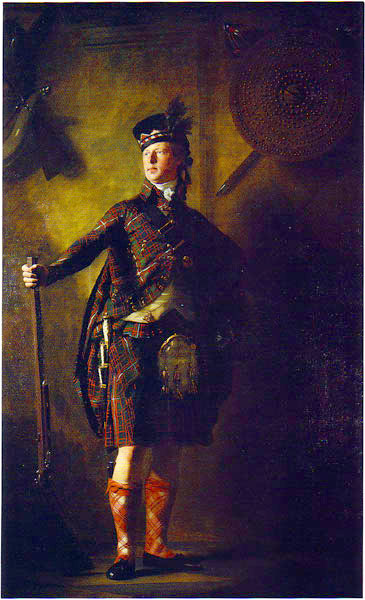|
Glengarry (also
Glengarry bonnet or Glengarry cap) is a type of cap which
Alasdair Ranaldson MacDonell of Glengarry invented and wears
in the portrait to the right: a boat-shaped cap without a
peak made of thick-milled woolen material with a toorie
or bobble on top and ribbons hanging down behind.
Colonel Alasdair
Ranaldson MacDonell of Glengarry (1771-1828) was a
personality well known to Walter Scott, a haughty and
flamboyant man whose character and behaviour gave Scott the
model for the wild Highland clan chieftain Fergus Mac-Ivor
in the pioneering historical novel Waverley of 1810. As was
customary for the chieftain of a clan, he was often called
simply "Glengarry".
He
was born in 1771 and became the 15th chief of Clan MacDonell
of Glengarry in 1788, shortly afterwards raising troops for
a regiment of Fencibles. As part of their uniform he
invented the Glengarry, a type of cap which he wears
in his portrait. Glengarry considered himself the last
genuine specimen of a Highland chief, always wore the
Highland dress (kilt or trews) and in the style of his
ancestors seldom traveled without being followed by his
"tail", servants in full Highland dress with weaponry who
had traditional duties like carrying his sword and shield,
standing sentinel, acting as bard and carrying him dry
across streams.
In
January 1828 Alasdair Ranaldson perished trying to escape
from a steamer which had gone aground. As his estate was
very much mortgaged and encumbered his son was forced to
sell it and move to Australia with his family. The estate
was purchased by the Marquis of Huntly, and in 1840 it was
sold to Lord Ward, Earl of Dudley, then in 1860 his lordship
sold it to Edward Ellice. After a lifetime of betrayals,
Alasdair Ranaldson's death was not mourned by the people of
Glengarry.
The
Glengarry continued to be worn in dark blue or rifle green
by all regiments of the Scottish Division up to the
amalgamation of all Scottish units into the Royal Regiment
of Scotland, as an alternative to the tam o'shanter,
particularly in parade dress (when it is always worn, except
by the Black Watch, who wore the Balmoral bonnet) and by
some regiments' musicians (who wear feather bonnets in full
dress). The current type of blue Glengarry worn by the Royal
Regiment of Scotland is with a red 'tourie', red, black and
white dicing, black silk cockade and the regimental cap
badge surmounted by cockfeathers, a tradition taken from the
Royal Scots and King's Own Scottish Borderers. Other
Commonwealth military forces, who also have Scottish and
Highland regiments, also make use of the Glengarry. The
Irish Defense Forces also employ the Glengarry and it has
been issued since 1922 to all units of the Cavalry Corps and
Reserve Army officers. The Irish Glengarry differs somewhat
to its Scottish forbearer in that the Irish is more akin to
a Caubeen with tails. The Glengarry is also commonly worn by
civilians, notably civilian pipe bands, but can be
considered an appropriate hat worn by any males with
Highland casual or evening dress.
The
correct method of wearing the Glengarry has changed since
the end of the Second World War. Prior to 1945, Glengarries
were generally worn steeply angled, with the right side of
the cap worn low, often touching the ear, and the side with
the cap badge higher on the head. The trend since the end of
the war has been to wear the Glengarry level on the head. |
 |

